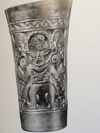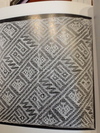Mesoamerica Exam 3 Flashcards

Valdivia Figurines
Valdivia Culture
Northern Coastal Desert
Lithic Period
10,000-3,000 BCE

El Caral
El Caral cultures
Central Coastal Desert
Cotton Pre Ceramic Period
3,000-1800 BCE

Cerro Sechin Reliefs
Cerro Sechin culture
Central Coastal Desert
Initial Period,
1800-1200 BCE

El Lanzón
Chavin Cultures
Central Mountain Highlands
Early Horizon
1200 BCE-200CE

Male and Female Staff gods
Chavin Culture
Central Mountain Highlands
Early Horizon
1200 BCE-200 CE

Raimondi Stone
Chavin culture
Central Mountain Highlands
Early Horizon
1200 BCE-200 CE
- Low relief and incision.
- Inverted other images are seen.
- Confusing images like this are usually associated with religion—beyond comprehension and confusing/mysterious.
- Upright—anthropomorphic figure
- Upside down—creature with telescoping mouth.
- Can tell which is upright because of the pendant eyes
- Called a staff god because of the staffs held in hands—a type of polymorph.

Stirrup Spout Vessel
Chavin
Central Mountain Highlands
Early Horizon
1200 BCE-200 CE

Paracas Bridge Spout Vessel
Paracas
Southern Coastal Desert
Early Intermediate Period
200 BCE-500 CE

Linear Style Textiles
Paracas
Southern Coastal Desert
Early Intermediate Period
200 BCE-500 CE
- Lots of geometric shapes. Thin lines usually, very repetitive,
- First to develop
- Horizontal, vertical, and diagonal lines
- Usually only 4 colors. Red, Green, Gold and Blue
- Often in columns with border designs
- Motifs tend to be nested images. i.e. cat within a cat within a cat.
- Appear to emphasize abstracted ideas.
- Straight/angular outline shapes
- Repetitive designs

Block color textiles
Paracas
Southern Coastal Desert
Early Intermediate Period
200 BCE-500 CE
- Curvilinear
- Varied imagery, usually not the same figure twice in the same textile.
- Outline every feature,
- Bright colors
- At least 19 different colors used in the same textile, sometimes as many as 100…
- A lot of their designs began with the Chavin staff god design.

Bridge-spout vessel of an achira
Nasca
Sourthern Coastal Desert
Early Intermediate Period
200 BCE-500 CE

Spider Geoglyph
Nasca
Southern Coastal Desert
Early Intermediate Period
200 BCE-500 CE
- Gigantic low relief sculptures on the ground.
- Look up nat geo article on it for visual step by step
- Monkeys, birds, whales, spiders, hummingbird—about 450 ft long, wings about 200 ft wide.
- Hummingbird, like Meso, represents or associated with war/warrior/soldier.
- Spider-also fierce animal.
- Associated with religion and ritual
- Could’ve been made to reflect their impressions of constellations
- Definitely used for ritual pilgrimage as they do today, and they all start at a point and end at the same point.

Great Warrior Priest rollout
Moche
Northern Coastal Desert
Early Intermediate Period
200 BCE-500 CE

The Huaca del Sol
Moche
Northern Coastal Desert
Early Intermediate Period
200 BCE-500 CE
- Bigger than the pyramids of Giza.
- Adobe structure
- Each level has a different brick mark and made by a different labor group.
- Largely destroyed by the Spanish because the Moche buried people and goods within the platform. Diverted the river to wash most of it away.
- Similar function to Huaca de la Luna

Tombs of Sipan Earspools
Moche
Northern Coastal Desert
Early Intermediate Period
200 BCE-500 CE

La Senora del Cao
Moche
Northern Coastal Desert
Early Intermediate Period
200 BCE-500 CE

























